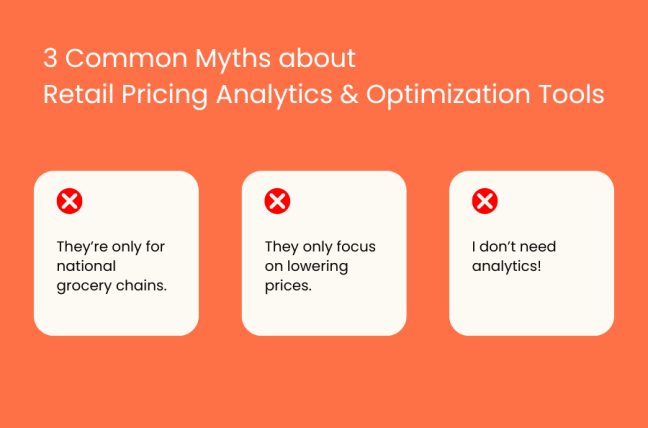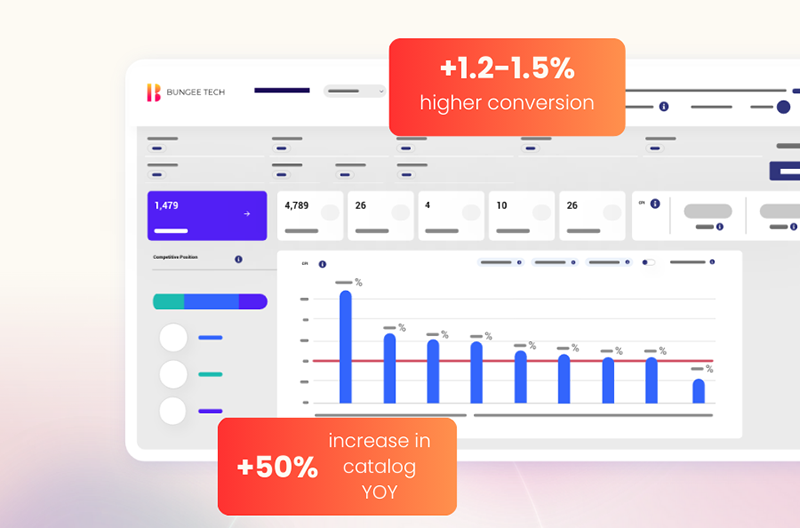Sponsored content

By Rajat Nigam, CEO and founder of Bungee Tech

From managing tight margins to streamlining operations, the path to profitability in grocery retail is full of obstacles. Amid these challenges, grocery retailers are turning to pricing analytics and optimization to execute effective, competitive strategies.
However, despite its proven benefits, some grocers remain hesitant to embrace this technology. Some are under the misperception that this technology isn’t designed for smaller operators while others believe it offers limited capabilities.
In this article, we’ll dispel three common myths about pricing analytics and optimization tools and shed light on their true value for independent and regional grocers. Keep reading to learn how modern pricing solutions are not only accessible but also essential for driving growth, improving efficiency, and enhancing customer satisfaction.

Myth No.1 – Pricing analytics tools are only for national grocery chains.
Reality: Knowledge is a superpower… no matter your size!
Contrary to popular belief, pricing analytics and optimization software is not exclusive to national grocers. While it’s true that large chains have been early adopters of these technologies, the benefits are equally significant for independent and regional grocers.
Retail pricing solutions like Retailscape by Bungee Tech are designed to be scalable and adaptable, making them suitable for businesses of all sizes. These tools provide a competitive edge, so that you can enhance your pricing strategies and improve profitability.
Pricing analytics and optimization solutions provide insights into market pricing, enabling grocers to make data-driven decisions for their own stores. Moreover, these tools help streamline operations, reduce manual pricing efforts and allow grocers to focus on other critical aspects of their business.
Myth No. 2 – Pricing optimization tools only focus on lowering prices.
Reality: Optimization is about finding the best price – the optimal balance between competitive pricing and profitability.
Pricing optimization considers various factors – from your strategy and rules to the market’s prices. Price optimization software recommends price adjustments that maximize overall profitability.
Outside of pricing, these tools offer independent and regional grocers many benefits:
- Promotion monitoring: Track the effectiveness of promotions and see when your competitors have items on sale.
- Assortment analytics: Determine the best product mix by identifying high-performing items and/or assortment gaps.
- Out of stock management: Monitor product availability and suggest price adjustments to prevent stockouts or overstocks.
Our clients have demonstrated that pricing optimization isn’t just about lowering prices. It’s about using data-driven insights to make better decisions across price, promotion, and assortment. A holistic approach drives profitability and enhances customer satisfaction.
[RELATED: Mastering Pricing Operations: Strategies For Independent Grocers]
Myth No. 3 – I don’t need analytics.
Reality: Even the most experienced grocers can benefit from data-driven insights.
Pricing analytics provides a deeper understanding of competitive dynamics, which can reveal opportunities and threats that may not be immediately apparent through intuition alone. Relying solely on personal experience and intuition can lead to missed opportunities and inefficiencies.
Analytics provide a data-driven approach that complements your market knowledge, offering deeper insights and uncovering trends that might not be immediately apparent.
Here’s an example: A regional grocery store chain implemented a pricing analytics tool to optimize their pricing. The analytics tool reveals that the store’s price for a popular brand of organic cereal is consistently lower than the market average. The tool provides recommendations on the optimal price adjustment that balances competitiveness with profitability.
The store remains competitive in the market by monitoring ongoing pricing data and making further adjustments as needed. This proactive approach helps maintain a balance between profitability and customer satisfaction.
Unlock Your Pricing Potential
While we’ve explored how pricing solutions aren’t just for national grocers, offer functionality to make informed price adjustments and are built to support your knowledge, there are even more misconceptions to address such as it’s too expensive, implementation is complicated and will disrupt operations, or even that it’s a one-time project.
We’ve seen firsthand how pricing analytics and optimization tools level the playing field for independent grocers. We focus on providing accurate, real-time data, so that they can effectively compete against larger chains and increase their market share.
The true potential of pricing analytics gives independent and regional grocers a competitive advantage. By investing in pricing analytics and optimization, grocers can not only survive but thrive in today’s challenging market.

